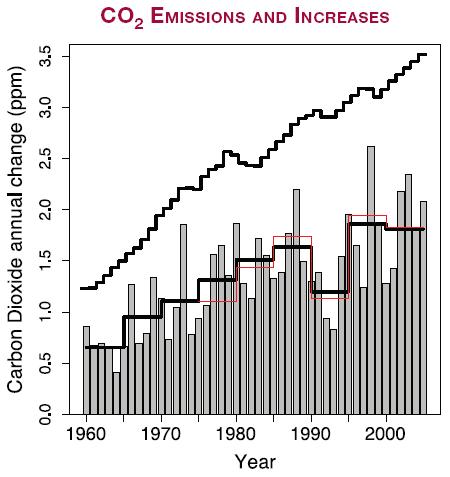I was reading the 2007 IPCC report’s 2007 Physical Science Basis and it came as a surprise how much variance there is from year to year in how atmospheric CO2 increases. CO2 emissions from burning fossil fuels remains relatively constant but the amount of that CO2 that actually stays in the atmosphere varies by over 100% from one year to the next. The mechanisms behind this variance are only partially understood. One thing we do know however is that old growth forest locks up huge amounts of CO2 in wood. Plant and animal use of CO2 is one of the mechanisms behind the variance. It seems like it might be much more economically viable and beneficially desirable to pursue reforestation instead of reducing CO2 emissions. A long-lived tree will lock up CO2 in wood for 50 to 100 years or more while it’s alive. If it’s harvested for lumber to build homes and other wooden structures that will keep the CO2 locked up in wood for another 50 – 100 years or more. By the time the wooden structures release the stored CO2 from rotting or burning we’ll have used up all the fossil fuel reserves and won’t have excess CO2 to dispose of anymore.
When the United States agreed in principle to Kyoto “carbon credits” were given for reforestation. The United States does a lot of reforestation and thus didn’t have to reduce carbon emissions very much because it got so much credit for reforestation. When it came time to ratify the treaty the carbon credits offered for reforestation were vastly reduced. The other parties involved in writing Kyoto reneged on their earlier agreement. That’s the primary reason the U.S. didn’t ratify it. This is more evidence of that Global Warming is driven by an agenda which is punish the United States economically by making it agree to reduce carbon emissions. If they were only concerned about CO2 buildup in the atmosphere they’d agree to let us plant enough trees to make up for our emissions (which we largely do already). This is far less costly than curbing fossil fuel burning. The problem in the eyes of much of the rest of the world is the United States holds too much economic and military power and they want that reduced. Getting us to encumber our economic growth through CO2 emission reduction is one way of putting the brakes on growing economic and military power.

Figure TS.3. Annual changes in global mean CO2 concentration (grey bars) and their five‑-year means from two different measurement networks (red and lower black stepped lines). The five-year means smooth out short-term perturbations associated with strong ENSO events in 1972, 1982, 1987 and 1997. Uncertainties in the five-year means are indicated by the difference between the red and lower black lines and are of order 0.15 ppm. The upper stepped line shows the annual increases that would occur if all fossil fuel emissions stayed in the atmosphere and there were no other emissions. {Figure 7.4}